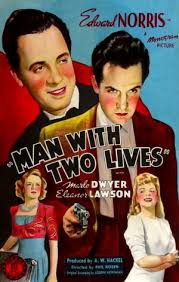
“Work to ease the pain of the living, not to bring back the dead.”
Phillip Bennett (Edward Norris) and Louise Hammond (Eleanor Lawson) are having an engagement party. One of the guests is Dr. Richard Clark (Edward Keane). He is doing experiments on bringing back the dead. At the end of the party Phillip leaves but is killed in a car crash. Phillips father Hobart Bennett (Frederick Burton) begs Dr. Clark to try to bring his son back to life.
Just before midnight Dr. Clark performs his resuscitation technique on Phillip. At the same time a criminal named Panino is executed in the electric chair. During the experiment the soul of the condemned man transfers to the body of Phillip. After the procedure Phillip appears to experience amnesia. He recognizes no one and remembers nothing of his life.
It doesn’t take long for Phillip to begin roaming Panino’s old haunts and taking up with Panino’s old girlfriend Helen Lengel (Marlo Dwyer) and running his old gang. After he kills the new leader that is. Thus starts a crime wave that the papers report as reminiscent of Panino.
Phillip’s family is concerned about his temperament and his absences from home. His father and Dr. Clark follow him to the bar where his gang hangs out. One of the gang members, Hugo, finds out who Phillip really is and tells Helen. When she confronts Phillip he kills her and then goes and kills Hugo. Unfortunately for Phillip, Hugo’s brother also knows who he is and he goes to the cops.
“The Man With Two Lives” was released in 1942 and was directed by Phil Rosen. It is shades of “Donovan’s Brain”. The only science fiction aspect of the story is the bells and whistles of the doctor’s equipment in the opening sequence of the movie. After that it’s pure cops and robbers. I’d call it a crime drama more than anything else. Except for the strange ending.
** Major Spoiler: There are two theories for the ending. One requires the viewer to believe that Phillip was in a coma after his accident and, when awakened, the events between the accident and his regaining consciousness were just a dream. The other requires the viewer to believe that Phillip did die and Panino’s soul entered his body. Then when Phillip was shot again Panino’s soul left his body and Phillip’s soul returned to his body. Since Phillip’s soul was outside our timeline his soul re-entered his body at the time he was originally revived. Apparently the switching back of the souls created a time displacement of sorts. The theory is that when the soul is body-less it is also timeless and a body can not have two souls occupy it at the same time. This means that Phillip’s soul was in a state of timeless limbo until Panino’s soul left it. At the point Phillip’s soul reentered his body it didn’t matter how long Panino’s soul had occupied it since he was not tied to our timeline. Time was, in a sense, overwritten by Phillip’s soul when it re-entered his body. **
A confusing theory, especially since I don’t believe I explained it very well, but still a more interesting theory than the first one. Suffice it to say, I found the second theory far more interesting and thus it made the movie far more interesting

